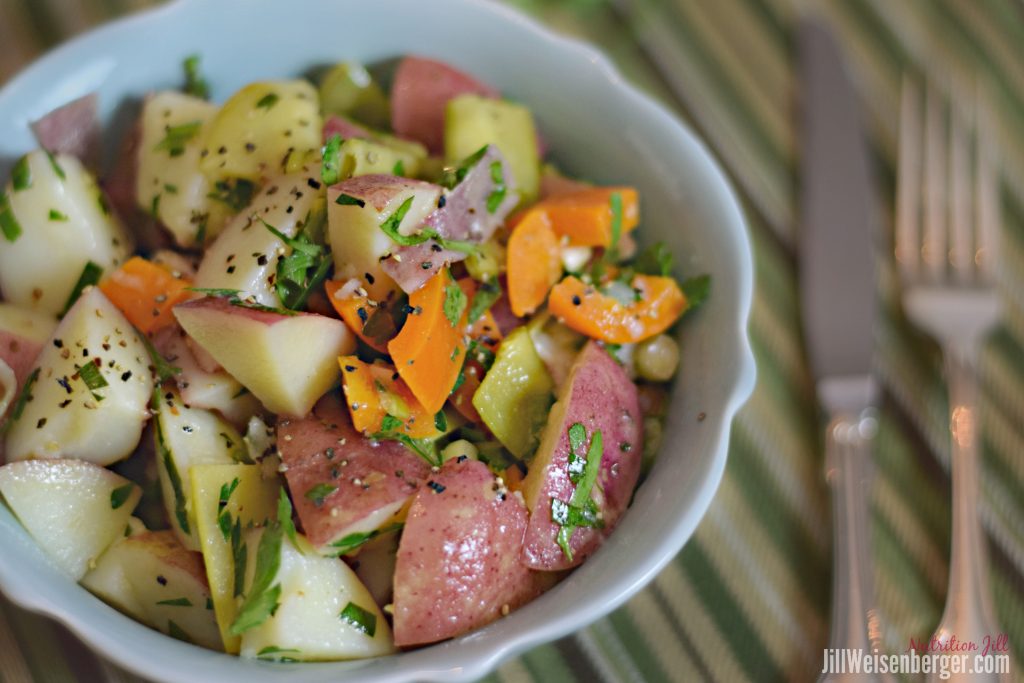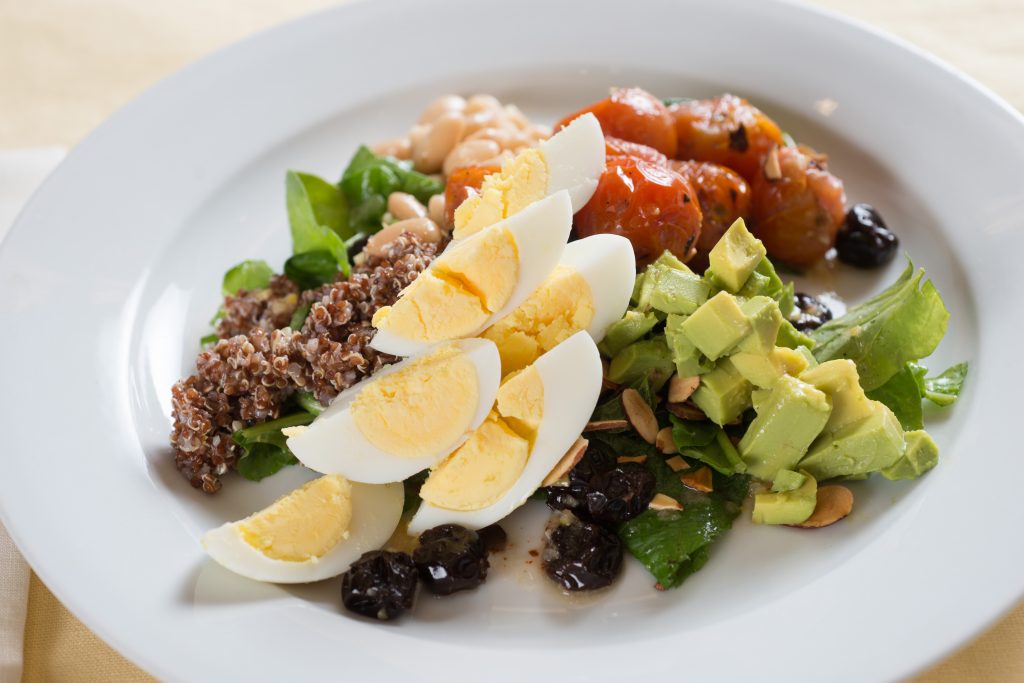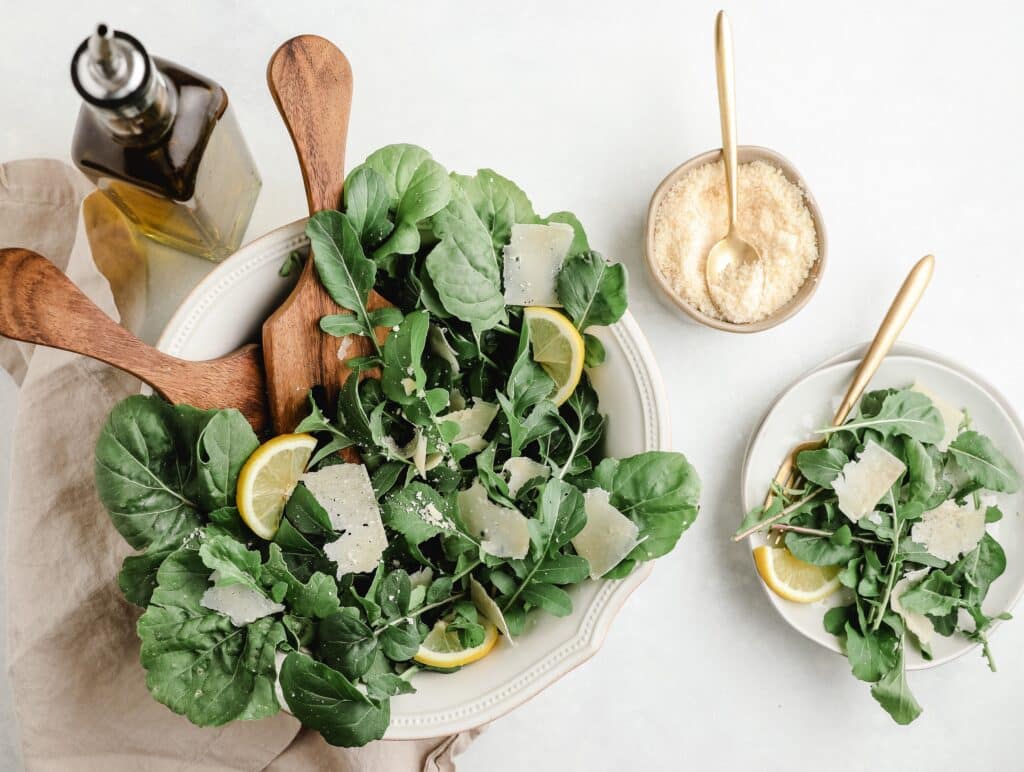Health Benefits of Resistant Starch and a Favorite Resistant Starch Recipe
Here are 7 resistant starch benefits, a list of foods that have it, and a delicious resistant starch recipe your family will love.
What if I told you there’s one type of starch you need more of?
Resistant starch doesn’t contribute to your blood sugar levels. It helps you manage your appetite, and it slightly lowers the calories in your food.
That does sound pretty amazing, right? So sign me up!

Veggie-Packed Potato Salad
What is Resistant Starch?
Resistant starch is a type of carbohydrate that escapes digestion in the small intestine and travels to the large intestine where our good gut bacteria ferment it. Specifically, resistant starch is a health-boosting type of fermentable fiber.
Some starches are more readily digested than others. Starches that slip through the small intestine without being broken down are called resistant starches – since they are resistant to digestion. And because you don’t digest them, their glucose molecules don’t get absorbed into your bloodstream. Yay, for lower blood sugar levels, especially if you have diabetes or prediabetes. Instead resistant starch serves as food for the bacteria in your colon.
Cooked and cooled potatoes – think potato salad – have resistant starch.
Are you sick and tired of eating the same foods everyday because you don’t know what’s safe for your blood sugar?
End the Confusion & Frustration of What to Eat for Type 2 Diabetes
7 Resistant Starch Benefits
Surely, there are more than a mere 7 resistant starch benefits, but these are the ones that I think about the most.
- You absorb fewer calories. Since resistant starch isn’t digested, you don’t get all of the calories available in that food. Your gut bacteria can have it instead. Now, please don’t go thinking you can down a bowl of potato salad without absorbing calories. Cold potatoes contain resistant starch, but not all starch in potatoes – not even most – is resistant starch. What a benefit that would be!
- You absorb less sugar into your blood. Since the starch isn’t digested, the glucose isn’t available to add to blood sugar levels, which is a nice health benefit for people with diabetes, prediabetes or insulin resistance.
- Your healthy gut bacteria thrive. When you feed resistant starch to your good gut bacteria, they thrive and make less room for the unhealthy bacteria to set up home. The good bacteria have lots of important jobs, so let’s feed them well. Here’s a few things your healthy bacteria do on your behalf.
- Produce vitamins
- Detoxify cancer-causing compounds
- Activate cancer-fighting compounds
- Activate other health-boosting compounds in various foods
- Your colon cells are protected. When those good bacteria ferment the resistant starch, they produce short chain fatty acids (SCFAs). SCFAs fuel the colon cells and many even increase the death rate of unhealthy colon cells. And that helps shield you from colon cancer.
- Bad stuff stays out of your bloodstream. If you’ve never given it much thought before, all the amazing things your intestines do is pretty awe-inspiring. Just consider the gut wall or intestinal barrier. That barrier must stop food particles, microbes and toxins from entering your bloodstream and traveling throughout your body. But at the same time, it must let in nutrients. Fortunately, when your good gut bacteria ferment resistant starch and some other fibers, they produce the SCFAs – particularly butyrate – that works to protect the integrity of your intestinal barrier. It’s complicated, but my geeky types can learn more here.
- You might be less insulin resistant. Insulin resistance is a hallmark of both prediabetes and type 2 diabetes. SCFAs can help your body use insulin better.
- You might not get so hungry. There are LOTS of types of fibers. Some – but definitely not all – help control appetite. Resistant starches seem to increase satiety, so you last longer after a meal or snack before getting hungry again.
Which foods are high in resistant starch?
The best sources of resistant starches are beans and other legumes, some whole grains and under-ripe bananas. Uncooked oats (as in muesli) is a good source, but cooked oats is not. Cooked oats is still a nutrient-dense food, however, so enjoy it often. Cooked and cooled starches like cold potatoes, pasta, beans and rice are also sources of resistant starch.
I think you’ll like my healthy potato salad recipe below even more knowing it has resistant starch.
Cold potatoes have resistant starch. So do these foods.Click To Tweet| FOOD | RESISTANT STARCH (g) |
| Under-ripe banana, 1 medium | 4.7 |
| Rolled oats, ¼ cup, uncooked | 4.4 |
| Oats, 1 cup, cooked | 0.5 |
| Pearl barley, ½ cup cooked | 1.9 |
| White beans, 1 cup cooked | 7.4 |
| Lentils, ½ cup cooked | 3.4 |
| Pumpernickel bread, 1 ounce | 1.3 |
| Pita bread, white, 2 ounces | 1.1 |
| Cold cooked potatoes, 3.5 ounces | 4.3 |

This recipe was originally published in Diabetes Weight Loss – Week by Week

Veggie-Packed Potato Salad
Ingredients
- 1 1/2 pounds red-skinned potatoes, cut into large bite-sized pieces
- 4 ounces snow peas, trimmed and cut into bite-sized pieces (about 1 1/4 cups)
- 3 tablespoons extra virgin olive oil
- 3 tablespoons seasoned rice vinegar
- 1/2 teaspoon kosher salt
- 1/4 teaspoon black pepper
- 1 teaspoon Dijon mustard
- 4 scallions, chopped (about 1/2 cup)
- 1 cup chopped red or orange bell pepper
- 1/2 cup chopped parsley
Instructions
- Place the potatoes in a large saucepan and cover with water. Bring to a boil, then reduce the heat so the water bubbles gently. Cook until the potatoes are nearly at desired tenderness, about 10 minutes. Just before the potatoes reach the desired tenderness, drop the snow peas into the pot and cook for 30-60 seconds. The snow peas should still have a bit of crunch. Drain and rinse in cold water to stop the cooking process.
- While the potatoes are cooking, whisk the oil, vinegar, salt, pepper and mustard together.
- Once the potatoes and snow peas are well drained, put them in a large bowl with the scallions, bell pepper and parsley. Pour the dressing over the potatoes and vegetables and mix gently. Chill well before serving.
Nutrition
Looking for more resistant starch recipes? Try these:
- Farro Waldorf Salad
- Red Quinoa Tabouli
- Bean and Barley Salad
- Mediterranean Chickpea Salad
- Lentil Sloppy Joes
- Lentil Sweet Potato Chili
Resistant starch is one tiny factor related to blood sugar management. There’s so much to know, and it shouldn’t be confusing. Grab The Beginner’s Guide to What to Eat with Type 2 Diabetes. Read the lessons and use the worksheets at your own pace.
Filed Under: Comfort Food Sides, Nutrition, Recipe, Side Dish and Appetizer, Side Salad
Tagged: diabetes, fiber, healthy comfort food, legumes, prediabetes, Resistant starch, weight loss
Jill Weisenberger
I'm Jill, and I believe simple changes in your mindset and health habits can bring life-changing rewards. And I don't believe in willpower. It's waaaay overrated. As a food-loving registered dietitian nutritionist, certified diabetes care and education specialist and certified health and wellness coach, I've helped thousands of people solve their food and nutrition problems. If you're looking for a better way to master this whole healthy eating/healthy living thing or if you're trying to prevent or manage diabetes or heart problems, you'll find plenty of resources right here.
Leave a Reply
16 Comments
Leave a Comment
Welcome to my Blog
Hi there! I'm Jill, a nutrition & diabetes expert and the author of 4 books.

I believe simple changes in health habits can bring you life-changing rewards.
And I believe willpower is way overrated.
Right here is where you can discover the mindset and habits to stick with healthy lifestyle choices most of the time - and drop the guilt when you don't.
Get the Second Edition!

Featured Posts










Looks fabulous! I love potatoes but had been avoiding them thinking they were just low value carbs. Happily I was wrong I think I’ll make this this weekend! Yum!
Thanks Patty! Hope you enjoy it. I previously consulted to the Alliance for Potato Research and Education, so I am aware that others hold that same opinion. I put much more value on the quality of the food and the total amount of food (total calories, really) than I do on what has carbs or fat. Potatoes are a really inexpensive source of potassium. They also have fiber, magnesium, vitamin C and an important phytochemical called quercetin. When it comes to potatoes, portion size matters.
Thanks for another great article Jill. Here’s a new reference for the resistant starch in potatoes – http://www.sciencedirect.com/science/article/pii/S0308814616305052. The short answer is Resistant starch was greater in baked (4.22 g/100 g) than boiled (2.93 g/100 g) potatoes, p < 0.0001, by ANOVA" and "Chilled potatoes contained more resistant starch (4.27 g/100 g) than hot (3.00 g/100 g) or reheated potatoes (3.45 g/100 g)
Oh so helpful! Thank you Rhonda!
Just curious, what would you guess is the resistant starch in a homemade oatmeal cookie made with old fashioned oats and only baked for about 10 minutes? Asking for a friend This article has now also enhanced my love for homemade power balls with raw oats
Thanks for this great article..and recipe!
Good question. All I have is a guess, but here goes: much less than raw oats, but more than typically-cooked oats. My reasoning is that with less liquid there’s likely less cell disruption. But, like I said, it’s a guess. And I agree about power balls with raw oats. Here’s one of my faves with chocolate and peanut butter.
Hi Jill,
Your blog looks so nice!
Judy
Aaaw, so sweet Judy. Thanks!
I love potatoes. Great post and can’t wait to try your potato salad recipe!
Thanks so much Kim! Enjoy!
I have never heard the term “resistant starch” before. Can it be considered similarly to “insoluble fiber”?
No, they are different things. Resistant starch is like fiber in that it evades our digestive enzymes in the small intestine. And like some types of fibers,it can nourish the gut bacteria. There are several types of insoluble fibers, several types of soluble fibers, and at least 4 types of resistant starches. The cool thing is that they behave differently in the GI tract, and all are valuable. That’s why eating a large variety of foods in the fruits, vegetables, grains and beans groups is so important. I wrote a couple other posts that explain more. Check out How to Throw a Dinner Party for Your Gut Bacteria and What You Need to Know About High Fiber Foods. And thanks for your question!
Where is the recipe, there doesn’t seem to be a link to it anywhere
Thank you for alerting me to a problem on my site. This is not the only recipe that disappeared. It’s now fixed. I appreciate your taking the time to let me know.
Delicious! I made this recipe tonight for a guest who doesn’t like mayo, so he’s been missing out on conventional potato salad all his life. He adored this potato salad, though. Thank you for posting it! I’ll make it more often.
A question about resistant starch, though: is the starch in a cold potato that has been reheated still “resistant starch” — or does it morph itself back into its non-resistant-starch form?
Oh yay! I’m so glad. I just got some small potatoes in my farm share. I think I’ll make this too over the weekend. I’ve asked this question of experts before, and they tell me that some of the resistant starch will remain, but not all.